| |
 |
Victoria |
British Columbia |
Canada |
Horizontal Dial |
Dial 1046 |
| An ordinary mass-produced horizontal dial mounted on a simply decorated cast concrete pedestal. 11.5" diameter, cast iron with verdigris finish. The dial face is inclined but in the wrong direction, opposite to what is needed to properly align the style to the polar axis (cannot be corrected because fixture is damaged). Appears to be a Model #2550 'Father Time' dial from Rome Industries. |
| |
| |
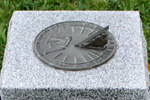 |
Murdock |
Nebraska |
USA |
Horizontal Dial |
Dial 1045 |
| This is a standard, but lovely, brass sundial 8 inches in diameter. Chapter ring has hour marks from VI to VI, with short hour lines extending inward from the ring. The gnomon has the traditional silhouette of a bird beneath the gnomon style. An hour glass centered in wings is below the foot of the gnomon. The Headstones of August and Mary Ruge have a marble pillar (12 x 12 x 24 inches) between them, and the dial is on the top of that pillar. |
| |
| |
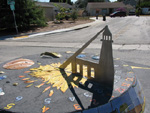 |
Santa Cruz |
California |
USA |
Horizontal Dial |
Dial 1044 |
| This is a colorful dial raised on a dais so that traffic doesn't hit it. Called "Light Time", the center of the dial has an artful yellow-orange impression of a sun surrounded by planets, moons and even a comet. Hours are marked in two colors for standard and savings time. The gnomon is 3/8 inch steel in the silhouette of a light house beneath the style line acting as a beam of light. |
| |
| |
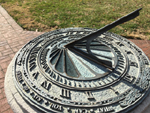 |
Louisville |
Kentucky |
USA |
Horizontal Dial |
Dial 1043 |
| This elegant brass horizontal dial was custom made for this site, as evidenced by the word GARDENCOURT and the site’s latitude 38° 15’ cast into the plate at the bottom. The dial is 13.75 inches in diameter, with a design of a series of concentric rings. The innermost ring has 17 lines radiating out from the foot of the gnomon toward the Roman numerals in the third circle. Each of these lines is connected by a graceful curve at its end to the adjacent line, creating a chestnut leaf motif in the inner circle. The next circle is a chapter ring of Roman hours marked from IV to VIII, embellished at the bottom with a stylized oak-leaf. A thin decorative band surrounds that ring. The outermost band contains the inscription and the name of the estate. The gnomon is a simple wedge, cut at the correct angle for the site. Unfortunately it is bent slight off true north. |
| |
| |
 |
Saint Louis |
Missouri |
USA |
Sun Alignment |
Dial 1042 |
| The sundial, or more properly an alignment gap in the shape of a cross, is cut into the south wall of the Cascade Mausoleum. The cross shaped gap was cut into a 32,000-pound block of granite located at the top of the second flight of stairs, carefully angled at 27.9 degrees through this two-foot-thick block. Every year, on Dec 20th at 11:58 am, the sun shines through the cut and projects a cross 4x 8 feet in size on the granite floor located at the bottom of the stairs. The cross illuminates the floor for about 4 minutes, only aligning on Dec 20th at solar noon. |
| |
| |
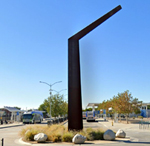 |
San Bernardino |
California |
USA |
Horizontal Dial |
Dial 1041 |
| This is a monumental horizontal sundial that from the ground simply looks like a giant pole with a slanting beam. High above the ground that beam is actually a segment of a gnomon, casting its shadow on the concrete plaza below. Then, if the eye is discerning, the concrete alternates in light gray and darker gray motif for the hour sections. From space (or Google Earth) the layout of the hour angles is clearly visible, radiating from a point considerably south of the gnomon pole, showing the hours from 9AM to 3PM local solar time. Hour line plaques extend from 10AM to 7PM. |
| |
| |
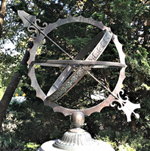 |
Louisville |
Kentucky |
USA |
Armillary Sphere |
Dial 1040 |
| This bronze armillary’s equatorial ring is 1.25 inches wide and 16.25 inches in diameter. The inside of the ring has Roman numerals denoting the hours from 5:00 AM to 7:00 PM. The outside of the ring is decorated with dogwood blossoms, a traditional Christian symbol of resurrection. The serrated meridian band is 1.25 inches wide and it has an outside diameter of 18 inches. The small horizontal band is 0.5 inches wide. The arrow is 29.5 inches long. It points in a westerly direction, meaning the dial is decorative but not useful for telling time. |
| |
| |
 |
Tucson |
Arizona |
USA |
Sun Alignment |
Dial 1039 |
| The Vista Sun Wheel is 63 feet [19.2 m] outside diameter and 197 feet [60 m] in circumference. The Wheel is composed of 28 tons of broken limestone. The central cairn is 11 feet [3.4 m] in diameter and 3 feet [1 m] high. In the center is a post marked by a sandstone block about 30 inches [76 cm] tall. The floor of the Sun Wheel called for another 28 ton of crushed decomposed red granite about 3/4 inch [2 cm] thick. Stone spokes indicate the solstices and equinox. Other stones 30-40 inches [75-100 cm] are set to various alignments outside the ring. A post indicates the setting sun on Groundhog Day, indicating one of the cross quarter days. The layout was made by direct observation, watching the progress of the sun along the horizon to solar standstill then return. 18 months were required to observe, mark and verify positions then setting stone and making the ring. The layout is similar to the Bighorn Wheel in Wyoming. |
| |
| |
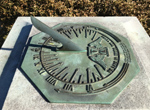 |
Louisville |
Kentucky |
USA |
Horizontal Dial |
Dial 1038 |
| This 11-inch (28cm) octagonal bronze horizontal dial uses arrowheads as a subtle design element. The 14 hour lines are represented as long arrows aimed at the base of the gnomon and are delineated to quarter hours. . The hours are marked in Roman numerals, but only from 6AM to 6PM. There are three curved lines of unequal length that partially encircle the dial indicating the amount of daylight in the and each one ends with a pointed tip. The marker for Noon resembles the Roman symbol for Mars, with its arrowhead pointing straight up. A winged hourglass graces the southern portion of the dial face. |
| |
| |
 |
Mountain View |
California |
USA |
Analemmatic Dial |
Dial 1037 |
| Analemmatic sundial 16' x 10' (4.8m x 3m) painted as a full ellipse on the driveway to a house. Shows local solar time. Time corrections to obtain civil time (Equation of Time and longitude offset) are given for the first of each month on the Zodiac Walkway. Sunrise and Sunset sighting points (seasonal or "Bailey" points) are provided for a theoretical horizon, but are not useful as the dial site is within a valley. The perimeter of the ellipse is marked with great circle navigation directions for a selection of historical solar and celestial observatories, especially for North America, but all historically inhabited continents are represented. A QR code is provided for a link to a website with instructions for the dial, reference links on sundials (including NASS), and links for the selected observatories on the perimeter. The 2 degree slope of the driveway was not compensated for in the sundial layout, but the dial is unshaded from roughly 9:00 am to 5:00 pm in the summer. |
| |
| |
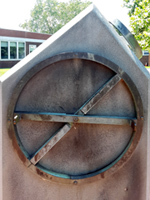 |
Annapolis |
Maryland |
USA |
Noon Mark or Meridian Dial |
Dial 1036 |
| This brass mariner's compass about 12 inches in diameter is mounted on the east side of a concrete pillar. It is known on campus as "The Ptolemy Stone". It functions as a meridian transit with altitude marks every half degree engraved on the upper south quadrant. The alidade has a notch on the upper end and a plate at the lower end, designed for measuring the altitude of the sun using the notch shadow (preventing eye damage of sighting the sun directly). The pillar is just over 3 feet tall with a sloped top. The main slope is that of the site latitude. A steeper "north face" is cut plane to the celestial equator. To make the equator "visible", a ring is mounted to the face. The ring casts no shadow on the equinox and from September to March is in shadow. A similar Ptolemy Stone is at St. John's campus in Santa Fe, NM. |
| |
| |
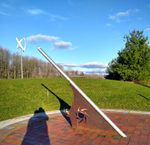 |
Montville |
Ohio |
USA |
Horizontal Dial |
Dial 1035 |
| The sundial gnomon is a metal pole about 4 inches (10 cm) diameter and 15 feet (4.5 m) long. Arabic numerals are engrave into stone paving blocks set on the perimeter of a 30 foot (9 m) circular brick plaza. The hour numbers are offset for both site longitude and daylight saving time. The gnomon is held metal work with a large sunburst in the center. |
| |
| |
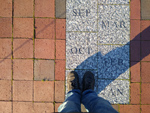 |
Montville |
Ohio |
USA |
Analemmatic Dial |
Dial 1034 |
| The zodiac walkway is made from 12 granite paving blocks engraved with abbreviated names of the months of the year. A nearby plaque instructs the observer to stand on the appropriate block to tell the time with one's own shadow. Time is indicated on inconspicuous bricks with black Arabic numerals. The hours are adjusted for longitude and set for Daylight Saving Times |
| |
| |
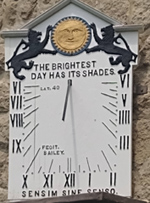 |
Youngstown |
Ohio |
USA |
Vertical Dial |
Dial 1033 |
| Since the wall of the house/museum does not face true south, this vertical dial is set atop a plinth mounted midway up the south-west wall. The 2 x 4 foot (61 x 122 cm) dial face appears to be painted white wood ornamented with a gold face of the sun held by two black heraldic lions. The gnomon is a simple rod and the dial is delineated for due south with "Lat 40°" painted on the dial face. However, the building is at 41° latitude. Along the periphery of the dial face painted in black are hours are marked in Roman numerals from VI to VI with lines showing hour lines and shorter lines for the half-hours. Quarter hours are marked with black dots. The sundial was restored within the past ten years. |
| |
| |
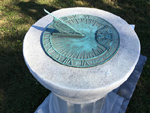 |
Louisville |
Kentucky |
USA |
Horizontal Dial |
Dial 1032 |
| The Griswold-style bronze dial is 11 inches (28 cm)in diameter and closely aligned to true North. The gnomon is set at a generic angle of 40°, while the site latitude is 38°. The dial sits atop a fluted stone column 38 inches (96.5 cm) tall that has a round cap of 16.5 inches (42 cm) diameter and 4 inches (10 cm) thick. The column sits on a two-part square base with an upper tier that is 17.75 inches (44.5 cm) on each side and 3 inches (7.6 cm) high and a bottom tier that is 22 inches (56 cm) on each side and 7.5 inches (19 cm) high and engraved with the family name “STEIN.” |
| |
| |
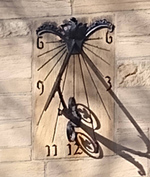 |
Boardman |
Ohio |
USA |
Vertical Dial |
Dial 1031 |
| This vertical dial fits well with the gothic style of the memorial chapel. The sundial gnomon and its fittings appear to be cast bronze, appropriately ornate and quite beautiful. Arabic numerals are chiseled into the stone wall, marking the hours of 6, 9, 11, 12, 1, 3 and 6. Other hour lines are unlabeled. |
| |
| |
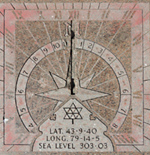 |
St. Catherines |
Ontario |
Canada |
Horizontal Dial |
Dial 1030 |
| This horizontal dial is engraved into a square block of pink granite with Roman hour numbers around the periphery and in Arabic numbers in an interior chapter ring. The gnomon was vandalized years ago and is totally missing. At the base of where the gnomon would sit is a compass rose. Southward on the dial face is the Centennial Maple Leaf and latitude/longitude and altitude. As of 2021 the dial face is rotated with noon facing due south. The square concrete pedestal has settled after 50 years and is to longer vertical. |
| |
| |
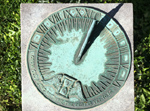 |
Louisville |
Kentucky |
USA |
Horizontal Dial |
Dial 1029 |
| The classic brass horizontal sundial is 11 inches in diameter with a large chapter ring of Roman hours marked from VI to VI. Noon is marked by "O". However, the hour and minute lines that extend inward and run in quarter hours from 4am to 8pm. At the south end of the dial is the traditional hour glass with wings. The gnomon is also classic with a bird supporting the style. Unfortunately the dial is aligned to magnetic north. The dial sits on a thick square cap 12 x 12 x 5 inches. Beneath is a graceful round pedestal 24 inches tall that rests on a square plinth 12 x 12 x 5 inches. |
| |
| |
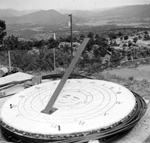 |
Cañon City |
Colorado |
USA |
Horizontal Dial |
Dial 1028 |
| This sundial was constructed in 1969 on the top of a 10-foot round column on a 75-ton block of reinforced concrete by Heron Construction Co. to anchor an aerial tram cables spanning 2200 feet across the Royal Gorge. The column was tilted away from the cables and the station on the opposite side of the gorge, so the dial face is inclined about 4 degrees, sloping in a direction about 9 degrees west of due south.The original dial was designed by William L. Peterson of Time & Space LTD, Denver, CO (said to be a sundial expert by a newspaper article, but no further r information), and painted by a local sign painter, Ray Hawes. |
| |
| |
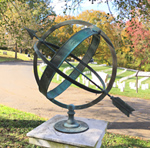 |
Louisville |
Kentucky |
USA |
Armillary Sphere |
Dial 1027 |
| This bronze armillary has equatorial and meridian bands 18 inches in diameter. The equatorial band is 2 inches wide with Arabic Hour marks on the inside of the band and zodiac symbols on the outside. The gnomon rod is a traditional arrow 31 inches long. The sphere’s metal base is 7.5 inches in diameter and is decorated with the signs of the zodiac. The armillary sits atop a graceful round column 37.5 inches tall, including the 14x14x2 inch cap. The base is 16x16x2.5 inches. This in turn sits on a two-tier dais 10 inches high with the top tier inscribed "RIDGE" for the family plot. |
| |
| |
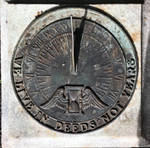 |
Louisville |
Kentucky |
USA |
Horizontal Dial |
Dial 1026 |
| This horizontal bronze dial is 9 1/2 inches in diameter with Roman hour marks from V to VII, delineated in quarter hours. Noon is marked by a thin trapezoid. Outside the dial is a surround of another ring with semi-circular words around the dial: "We live by deeds, not years". A classic hour glass with wings decorates the dial face. The gnomon is in good condition, but slightly bent. The dial sits atop a white marble pedestal 45 inches tall. The pedestal sits on a base two-foot square approximately 13 inches in height. Above the base the pedestal tapers upward, narrowing to an 11 inch square that holds the dial and the surround. |
| |
| |
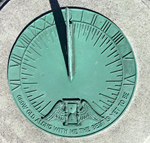 |
Louisville |
Kentucky |
USA |
Horizontal Dial |
Dial 1025 |
| The classic brass horizontal sundial is 10-1/2 inches in diameter with a large chapter ring of Roman hours marked from VI to VI. Noon is marked by "O". However, the hour and minute lines that extend inward and run in quarter hours from 4am to 8pm. At the south end of the dial is the traditional hour glass with wings. The gnomon is also classic with a bird supporting the style. The dial sits on a granite cap 7 inches thick held by a decorated and fluted column 22-1/2 inches tall. This in turn sits on a two-tier dais 14 inches high with the top tier inscribed "VAUGHAN" for the family plot. |
| |
| |
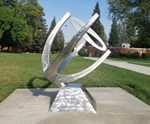 |
Sacramento |
California |
USA |
Equatorial Dial |
Dial 1024 |
| A 6 foot wide x 5-foot high burnished stainless steel equatorial sundial. The meridian arc is parabolic shaped and the equatorial arc is slightly more than a gracefully tapered half-circle 5 1/2-feet in diameter. The central elliptical gnomon plate, which swivels to face the sun, has an analemma cutout that casts an accurate civil-time shadow onto the equatorial ring below. The gnomon plate is laser-etched with the analemma, months and 365 days of the year, and marks for the equinoxes and solstices, and instructions. The equatorial timeline is laser-etched with hour and minute marks from 6:30 AM to 6:30 PM. The sundial body rotates and locks in position for either Daylight Saving or Standard Time. The sundial is highly accurate compensating for longitude (the equatorial ring is rotated 5min 24 sec early to measure solar time on the pacific meridian) and equation of time (by reading the east or west edge of the analemma plate gnomon shadow). The sundial often indicates clock time to within seconds and the date to within a portion of the day. A stainless steel base cover encloses the mounting hardware beneath. |
| |
| |
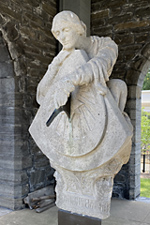 |
Bala Cynwyd |
Pennsylvania |
USA |
Vertical Dial |
Dial 1023 |
| This is a statuary of a saddened maiden leaning over a vertical dial. The hour lines are thick lines radiating from the foot of the gnomon from 5am to 5pm. The maiden's hand lays over the bronze gnomon. In the center of the dial is a compass rose. This may be an 18th century statuary, a cast copy of a dial and statue in London. |
| |
| |
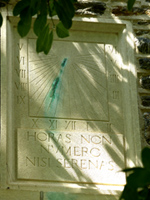 |
Haverford |
Pennsylvania |
USA |
Vertical Dial |
Dial 1022 |
| Not too far up the wall of Union Hall is this vertical rectangular dial about 2x3 foot in size. The limestone dial is embedded in the stone block wall. The declining dial has hour lines every half hour from 5am to 6pm, but the gnomon is missing, leaving only a bronze stain on the light stone face. Most disturbing is a magnolia tree planted by the class of 1972 that now totally blocks sunlight from reaching the dial. |
| |
| |
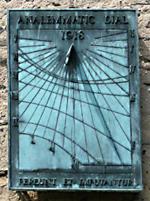 |
Haverford |
Pennsylvania |
USA |
Vertical Dial |
Dial 1021 |
| This bronze vertical dial is about 2x3 feet with a splotched green patina. The hour lines and Roman markers go from 5am to 7pm. The tip of the gnomon shadow shows the date among declination lines from solstice to solstice. It is inscribed as an analemmatic dial, but only because at the noon hour is the trace of the analemma. Considering the motto on the dial, this was probably erected as a memorial to those lost in The Great War. |
| |
| |
 |
Haverford |
Pennsylvania |
USA |
Vertical Dial |
Dial 1020 |
| Vertical dial about 2-foot square high up on the east wing of KINSC. The limestone dial is embedded in the stone block wall. The declining dial has hour lines every half hour from 5am to 4:30pm. The gnomon is in excellent condition and has not left brass stains on the dial face. |
| |
| |
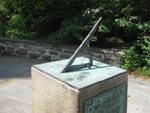 |
Haverford |
Pennsylvania |
USA |
Horizontal Dial |
Dial 1019 |
| A rectangular horizontal dial about 18 x 12 inches. Heavily weathered, but Roman hour lines from 6am to 6pm with noon gap still visible. Original 5 minute hour marks barely visible on rim. The gnomon went missing some years ago and was retrieved on eBay, and is retained by the college. |
| |
| |
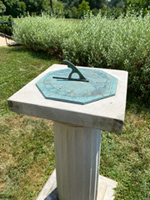 |
Swarthmore |
Pennsylvania |
USA |
Horizontal Dial |
Dial 1018 |
| This octagonal dial was given to Swarthmore in memory of their classmate Howard White Jr. The dial was originally placed in the Scott Arboretum on Parish Lawn but was removed for pathway reconfiguration in 2006. An alum Bob Thompson found that the dial was stored under the bleachers alongside Skallerup Track. n honor of Thompson’s 92nd birthday, the Arboretum returned the sundial placing in in front of Pearson Hall for the next generation of students to enjoy. |
| |
| |
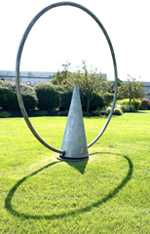 |
Philadelphia |
Pennsylvania |
USA |
Noon Mark or Meridian Dial |
Dial 1017 |
| This meridian dial titled "The Point Where Things Change" was commissioned by the Redevelopment Authority of the City of Philadelphia. It is a large 8-foot (2.4m) diameter hoop aligned north-south. The gray painted hoop is supported at its base, covered by a narrow steel sheet cone also painted gray. The meridian dial and cone are slightly raised above a concrete pad. During the morning the shadow climbs up the AM side of the cone, at noon it rests directly on the point, and in the afternoon it starts to descend down the PM side of the cone. The Redevelopment Authority budgeted $18,000 for the meridian dial as a public art project. |
| |
| |
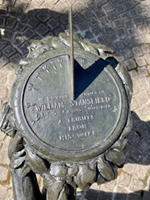 |
Philadelphia |
Pennsylvania |
USA |
Horizontal Dial |
Dial 1016 |
| In a small plaza is a beautiful bronze statue of Pan with Flute. The statue is 36 x 20 x 18 inches. His shoulder is bent to hold a 12-inch bronze sundial. Along the edge of the dial are Roman hour marks from 5am to 7pm. "In 1938, Mrs. William Stansfield presented the bronze statue, “Pan with Sundial,” to the University in memory of her husband, an alum from the class of 1902. The work is by Philadelphia native Beatrice Fenton, a figurative sculptor and portraitist who studied at the School of the Philadelphia Museum of Art and the Pennsylvania Academy of the Fine Arts. Fenton exhibited her work as the 11th member of the “Philadelphia Ten”—a group of women artists—as well as at the Art Institute of Chicago, the 1939 New York City World’s Fair and, in 1976, the Philadelphia Museum of Art. From 1942 to 1953, Fenton taught sculpture at the Moore Institute of Art. |
| |
| |
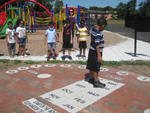 |
Baltimore |
Maryland |
USA |
Analemmatic Dial |
Dial 1015 |
| This red brick analemmatic is an ellipse 18x12 feet (6x4m). It has concrete stone inlays for the zodiac walkway and hour stones from 5am to 7pm in black lettering. At the edges are markers for the cardinal points and along the east-west line are the seasonal points (Bailey Points) for determining the direction of the rise and set of the sun. |
| |
| |
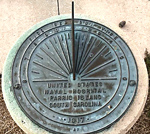 |
Beaufort |
South Carolina |
USA |
Horizontal Dial |
Dial 1014 |
| Farenholt sundial for U.S. Naval Hospital Parris Island SC. This cast bronze dial was designed and commissioned by RADM Farenholt for U.S. Naval Hospitals at bases where he was commanding officer, visited, or had special meaning to him. The dial is 18 inches (46cm) in diameter. The outer chapter ring has the motto, followed by a chapter ring with Arabic hours 6am to 6pm, raised hour lines that radiate from near the foot of the gnomon and short half-hour lines. The gnomon has graceful curves and a star cut-out in the center. Below the gnomon is the naval command name, followed by the commissioning date in the southern portion of the hours chapter ring. |
| |
| |
 |
Buffalo Valley |
Tennessee |
USA |
Horizontal Dial |
Dial 1013 |
| This monumental size sundial is called "Marking Time: and spreads over an area 100 x 50 feet (30 x 15 m). The gnomon is a 12 foot (3.6 m) tall welded stainless steel structure. The last several feet of the gnomon is a thin metal bar ending in a sharp point. Multiple time markers are arranged in hour lines from 6am to 6pm. These marks have the names of all 95 Tennessee counties and the noon line has only one county, Davidson, in tribute to the state capital in Nashville, Davidson Co. The large concrete base of the gnomon has fossil type imprints on the surface. |
| |
| |
 |
Great Falls |
Virginia |
USA |
Analemmatic Dial |
Dial 1012 |
| This 12-foot E-W analemmatic sundial was the Eagle Scout project of Kenny Dieffenderfer who marshaled volunteers from Troop 1547 and parents. The dial has hour marks of bright yellow radiant suns from 5am to 7pm local time. The zodiac walkway is 30 inches wide, painted with a white background and line marks for each month and appropriate colorful drawings. The equinox is clearly marked and surrounding the dial are the cardinal markers of N, S, E, W. |
| |
| |
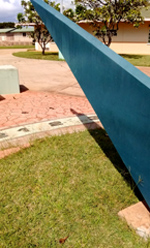 |
Ewa Beach |
Hawaii |
USA |
Horizontal Dial |
Dial 1011 |
| This is a large horizontal dial with a blue metal gnomon. At 21 deg latitude, the gnomon's low angle is distinguishing. Along the perimeter of half circle are Arabic numbers marking the hours from 6am to 6pm set between two concrete chapter rings. Just beyond the dial to the north is a an concrete bench that arcs across the 10am-2pm shadow line. The dial and bench are situated at one end of a long green corridor between the school buildings. |
| |
| |
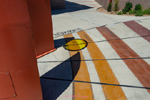 |
Denver |
Colorado |
USA |
Gnomonic or Projection Dial |
Dial 1010 |
| This gnomonic sundial uses an oculus high above ground level to project sunlight through a large overhead disc made of yellow plexiglass with a hole in the center to provide a brighter spot of sunlight surrounded by a yellow ellipse to show date and time. The light projects onto a large gnomonic calendar in colored concrete designating the months and hour lines from 10am-2pm standard time. Summer hours are designated from 11am-3pm. |
| |
| |
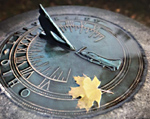 |
Athens |
Ohio |
USA |
Horizontal Dial |
Dial 1009 |
| For a dial 114 years old, it is in excellent condition. The bronze dial is of simple form with hour marks every quarter of the hour and a chapter ring with Roman hours from 5:30am to 6:30pm. Surrounding the chapter ring it reads "Ohio University". Father time stands with a scythe at the foot of the gnomon that contains the profile of a bird. On the dial plate Shakespeare's Sonnet 16 is lightly engraved. The sundial was erected in 1907, though there is a photo of "a quartet of gentlemen" attributed in 1890, yet the cylindrical pedestal with plaque is easily recognizable. |
| |
| |
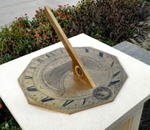 |
Westville |
Indiana |
USA |
Horizontal Dial |
Dial 1008 |
| This marine brass sundial at first glance is just a beautiful horizontal sundial with Roman hour marks delineated at 1 minute intervals from 5am to 7pm . But look carefully and at the base of the gnomon on the north side is a vertical stile whose shadow graces a stereographic projection of a grid of 5-minute solar time lines vs solar declination at degree intervals spanning +/- 23.5 deg where the summer and winter solstice paths are highlighted by a bead of small solar dots. |
| |
| |
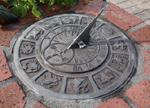 |
Ventura |
California |
USA |
Horizontal Dial |
Dial 1007 |
| The central part of the bronze sundial, approximately 12 inches in diameter, has the traditional hour marks and divisions into 15 minute intervals and surrounded by Roman numerals from 5am to 7pm. South of the gnomon is a simple compass rose with four cardinal points. With the dial at ground level the gnomon has led a hard life and is now held to the dial plate with improvised brackets. Surrounding the dial, doubling the size to 24 inches in diameter is an elegantly engraved ring of the twelve figures of the zodiac, each named on the outer ring with the corresponding month on the inner ring. |
| |
| |
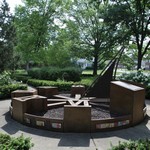 |
Indianapolis |
Indiana |
USA |
Horizontal Dial |
Dial 1006 |
| Nestled among the trees in a small triangular park is a monumental horizontal sundial with oversized hour marks. The apparent method of reading the Roman hours that are all south of the 6am - 6pm line, is to look at the shadow then gaze across the sundial to read (upside down) the hour. The hours are 6, 9 ,12, 3, and 6. On the north side of the 6am-6pm line are 3 plaques where the normal 9, 12, and 3 hours should be. One is a plaque for Robert McCord who planted and maintained the park during the 60's until his death. Another plaque records that the McCord Park sundial is dedicated to a local police officer, William Whitfield, who was the first African American police officer killed in the line of duty in Indianapolis. His name is engraved on the central part of the large triangular sundial gnomon. Surrounding the base of the sundial are ceramic tiles from Barbara Zech, a local clay artist who fired the tiles created by students from the nearby school. The tiles have the theme of "home" and "community". The park renovations were headed by the group Keep Indianapolis Beautiful. |
| |
| |
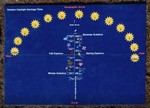 |
Marshfield |
Massachusetts |
USA |
Analemmatic Dial |
Dial 1005 |
| This beautiful and educational analemmatic sundial is painted on the blue background of a 14x10 foot concrete pad. The ellipse itself has a semi-major axis of 76 inches and a semi-minor axis of 48 inches, particular suited for children. The zodiac walkway is nicely painted in white with clean stenciling of the months. The solstices and equinoxes are marked in large letters and the cardinal points are flagged in red. [Note: a number of vendors will make paper or plastic stencils that with a stiff brush create impressive lettering.] The hour marks are bright yellow suns enumerated in standard time and offset for longitude. The paint is covered with a clear sealer (Duromar DF-5610 “Solventless, Zero VOC, UV Stable Clear Polyaspartic Topcoat”) plus a bit of "shark grit" (Duromar DuroTrac "Invisible Traction Grit") to roughen the surface a bit to give some traction. This is similar to the approach taken by John Carmichael for the dial he designed at the University of Arizona, NASS Registry #825. |
| |
| |
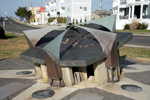 |
Longport |
New Jersey |
USA |
Sun Alignment |
Dial 1004 |
| This concrete and bronze dial is really an alignment sculpture, honoring events from Armistice Day (Nov 11, 1918) to Pearl Harbor (Dec 7, 1941). A five-vaned support casts a shadow onto brass medallions on the time and date of the event such as the 11th hour of the 11th day of the 11th month for Armistice (Veterans) Day. Surrounding the dial are five bronze plaques representing the different branches of the U.S. armed forces. |
| |
| |
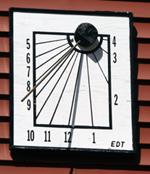 |
Norwell |
Massachusetts |
USA |
Vertical Dial |
Dial 1003 |
| This vertical declining dial is made of painted plywood with a simple white background and black hour lines and Arabic numerals. The gnomon is a brass rod without nodus. The hour lines have been adjusted for the difference between the site's longitude and the 75° W standard-time meridian. The hours are numbered as Eastern Daylight Time (EDT) instead of Standard Time, because in winter the sun is mostly low in the sky and trees in this wooded area block sunlight from reaching the sundial. Of course to obtain correct EDT, the equation of time needs to be added to the dial's time to account for the variable meridian passage of the sun. At most this amounts to -14 minutes (mid-February) or +16 minutes (early November). |
| |
| |
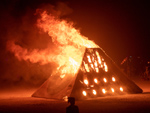 |
Black Rock City |
Nevada |
USA |
Equatorial Dial |
Dial 1002 |
| "About Time" was a 30 foot long, 3000 pound wooden pyramid. This installation projected time using two sundials: a gnomonic vertical sundial that swept its shadow of time out across the desert floor and an equatorial dial located on one faces of the pyramid. A platform at the peak of the pyramid allowed observers to become the gnomonic sundial’s apex and to experience 360 deg views of the landscape. At the end of the installation the piece was burned, a testament to the unidirectional march of entropy and time, underscoring the fleeting nature of the present moment. |
| |
| |
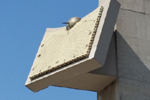 |
Mexico City |
México |
Mexico |
Vertical Dial |
Dial 1001 |
| This is a south facing reclining vertical sundial made of stone about one and a half meter square. The dial's concrete mount adjusts the dial to true south even though the carillon tower is not N-S aligned. Hour lines and Roman numbers on the dial go from 7am to 5pm. Monthly declination lines show the date as well as the solstices and equinox. A simple rod gnomon exits a gold ball at the top of the dial. The dial itself is well above eye level and hard to read. The other end of the carillon tower has an Aztec calendar. |
| |
| |
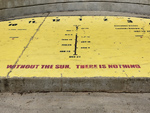 |
Milwaukee |
Wisconsin |
USA |
Analemmatic Dial |
Dial 1000 |
| During the design of the bridge across the lagoon, the walkway was extended in the center on the north side, creating a niche for a 12 x 6 foot analemmatic dial. The dial is painted bright yellow with hours marked from 5am to 9pm (daylight saving time). The 1pm hour mark is set 8 1/2 minutes past local noon corresponding to its location just east of the Central Time Zone meridian. The walkway is marked with a central line using tic marks for each month and solstices. As of 2019, the paint is well worn. The dial has red circular Bailey marks for observing the direction of sunrise and sunset. Latitude and longitude are painted on the dial as well. At the north side of the dial on bridge railing is a sign explaining how to stand on the dial and use the equation of time chart to get civil time |
| |
| |
 |
Anchorage |
Alaska |
USA |
Sculpture/Artwork |
Dial 999 |
| A sun sculpture called "Solar Path". The large 24 x 35 x 12 feet sculpture made by renowned artist Bill FitzGibbons consists of a blue vertical pole and two low sloping wedges. The vertical column makes a linear shadow that is supposed to show approximate solar time as it passes over evenly spaced inlaid hourly numbers from 8am to 8pm. This is not a functional sundial! The short wedge points to where the sunrises on the summer solstice and the longer wedge form points to where the sunrises on the winter solstice. |
| |
| |
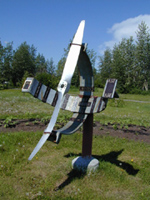 |
Fairbanks |
Alaska |
USA |
Equatorial Dial |
Dial 998 |
| This equatorial sundial uses the shaft hole of an old airplane propeller as a nodus to cast a sun beam spot on the equatorial band. The arms are made from pieces cut from an unused pipe section intended for an oil pipeline. The dial appears to have time zone compensation. The hour marks are labelled for both Standard and Daylight Saving Time (with no minor marks). The propeller hole shines light onto the words "summer", "equinox", and "winter". |
| |
| |
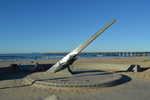 |
Port Hueneme |
California |
USA |
Horizontal Dial |
Dial 997 |
| A large, 20 ft. diameter horizontal bronze dial constructed in memory of Alaska Airlines Flight 261, which crashed 14 miles offshore nearby on January 31, 2000, with the loss of all aboard. 88 bronze plaques surround the dial on its beveled edge honoring passengers and crew who died. The dial face is simple without hour lines but Roman numerals from 8am to 4pm to mark the hours. The thin, gleaming gnomon is decorated with dolphins at the base symbolizing the sea into which the plane fell. The sundial is set in a circular plaza 36 feet in diameter. |
| |